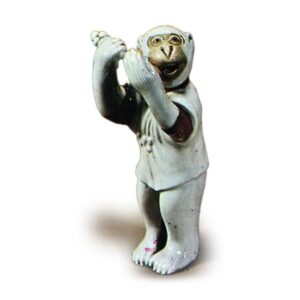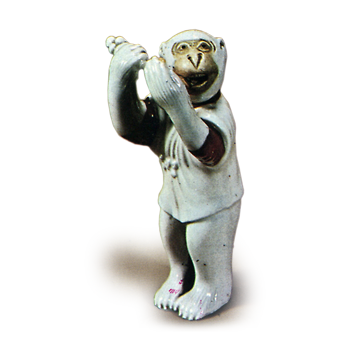
Porcelain from Mikawachi, Sasebo City, Nagasaki Prefecture. Also called Mikawachi ware. The name “Hirado-yaki” comes from the fact that this kiln was the official kiln of the Matsuura clan, the feudal lord of Hirado, and Mikawachi is located 52 km from Hirado.
During the Keicho’s Joseon War (1597-18), the lord of Hirado, Shigenobu Matsuura, returned with dozens of Koreans, among whom a native of Kumagawa named Geoseki was particularly skilled in pottery making. This is called Nakano ware. His son, Sannojo, was later given the family name of Imamura. He was engaged in pottery making with his father, but in 1622 (Genna 8), he was ordered by the lord to roam around with his father’s retainer Kyubei and other apprentices to discover pottery clay, and temporarily resided at Yoshinomoto in Oriose Village (Kihara Town, Sasebo City) to explore various places. As a result, he found potter’s clay at four locations in Mikawachi-Men Koaza Yoshida (Mikawachi-cho), Aikiba (Mikawachi-cho), Hayaki Village Aza-Gonjoji (Gonjoji-cho), and Hiu Village Aza Higashinoura (Hiu-cho), where he conducted research on test firing.
Another man named Koraibo came from Shiinomine (Minamihata-cho, Imari City, Saga Prefecture) and lived temporarily in Mikawachi, where he made pottery. His hair was also a master craftsman and was highly praised by the public and called Koryo ware. At the suggestion of his father, Sannojo worked to discover pottery clay while studying pottery techniques, and in 634 he discovered a white clay field in Mitsudake, Egami-mura (Egami-cho, Sasebo City) in his domain. In 1637, with the support of his lord, he moved to Mikawachi Maruyama and set up a factory at Nagahayama. During this period, Sannojojo learned the art of porcelain making by apprenticing himself to Goroshichi Takahara of Minamikawahara, Arita, Ryuzoji Territory, and had his wife steal the method of mixing glaze. In 1643 (20th year of the same year), with the permission of the feudal lord, he set up separate pottery factories at Kiharayama (Kihara-cho, Sasebo City) and Enagayama (Enaga-cho, Sasebo City), and sent his apprentice Oyamada Sahei to Kiharayama and Tatsujiro to Enagayama to take charge of them. Sannojo himself became the head of the three mountains and was in overall charge of them. Sannojojo’s son, Yajibei Nyozaru, who was engaged in the pottery business following his father, finally discovered amakusa stone in 1662 (1712-, Shoutoku 2, or the year of Genbun, 173641, according to Yokoishi Tochibei) and succeeded in making porcelain. He succeeded in making porcelain. The technique of Nyozaru became so exquisite that his fame spread far and wide, and he was ordered to make official offerings and gifts to the lords and lords, and even received orders to make gifts to the imperial court. Since then, the lords established a local government office to administer all aspects of the pottery. The Imamura family, from Nyozaru III to the eighth generation, all took the name Yajibei, followed by Doitaro the ninth, eight (8), ten (10), eleven (11), and twelve (12) generations, while the Koraibori lineage continued with the name Nakazato Moemon until the fifth generation, followed by Monemon the sixth, Togoro the seventh, Toshichiro the eighth, Shigetaro the ninth, and Tokuju the tenth. The kiln was under the jurisdiction of the local magistrate and had about 20 potters, including a wheelwright, a twisting wheelwright, and a painter, each of whom was given a two-person allowance, and had a well-organized structure called the Mikawachi Gokkosho.
Around 1837, Ikeda Yasujiro produced pure white porcelain as thin as an eggshell. Between Bunka (1804-1188) and Tempo (1830-1444), there were orders from the Dutch for coffee utensils through a merchant in Nagasaki, and Imamura Uchitaro reported this to the feudal lord, who actively manufactured them. The clan also dispatched an official to Nagasaki to set up a Hirado ware products exchange, and sold the products single-handedly. In 1865, Eitaro Fukumoto took charge of the business, which was handed over to Sumiji Furukawa in 1871. In 1874, Furukawa transferred the business to Teshima Seiji, and Teshima further expanded its sales channels to various regions. The above is an outline of the history of the business, but it is unique in that the Matsuura family, the feudal lord of the domain, continued to support the business from beginning to end, compared to this type of business in other domains.
The first product was pottery. The “Appendix to the Pottery Study” states, “There is a small hut of white clay and rat medicine in Karatsu, which resembles a well. After Sannojo Imamura created porcelain, the pottery became exclusively porcelain, and by 1699, it had progressed to the point where it was used to produce vessels presented to the Imperial Household for the Imperial Prohibition. During the Mikawachi Gokosho period, the company produced a blue-and-white work depicting Chinese children playing under a pine tree, which was prohibited for sale as a particularly valuable item and was offered only as a gift to the shogunate and to lords and princes. There were three types of karako: seven karako, five karako, and three karako, with the seven karako being considered the best. Later, the kiln produced twice-fired ware with red glaze and gold brocade, etc., and its products included vases, teapots, bowls, tokuri (Japanese tea utensils), mizusashi (water jars), mizunomi (water cups), sake cups, coffee containers, flower vases, inkstone screens, sencha bowls, tea sets, incense burners, water containers, and braziers. The characteristics of this kiln reflect the fact that it was the official kiln of the Hirado domain throughout its history, and can be summed up in one word: exquisite. The pure white base material and beautiful finish are modeled after the exquisite wares produced in the official kilns of China during the Kangxi, Yongzheng, and Qianlong periods (1662-1795) of the Qing Dynasty. Next, Hirado ware, like Nabeshima, does not have a fixed standard for form, but rather seems to emphasize porcelain quality and decoration. This indifference to form is one of the shortcomings of Hirado ware. The difference between Nabeshima and Hirado lies in the fact that Hirado ware has a much more delicate and delicate feel in its painting than Nabeshima ware. In addition, the gosu on Hirado ware is generally brighter and brighter than that on Nabeshima ware. (Tekkan Zoki, Koshi Yawa, Matsuya Wenki, Touki Kou Appendix, Honcho Touki No Kangaeshi, Kogei Shiryo, Prefectural Touki History Toukou Traditional Magazine, Koukai Shishi, 3, Dai Nihon Kogyo Kyokai Zasshi, 85, Kanko Zusetsu, Toki Rui Shu, Nihon Toki Shi Ron, Nihon Kinki Kengyo Shi, Hirado Yaki History List, Toki Koza, 2)



